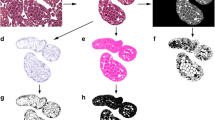Abstract
The study of biology and population dynamics of fish species requires the estimation of fecundity in individual fish in a routine way in many fisheries laboratories. The traditional procedure used by fisheries research is to count the oocytes manually on a subsample of known weight of the ovary, and to measure few oocytes under a binocular microscope. This process could be done on a computer using an interactive tool to count and measure oocytes. In both cases, the task is very time consuming, which implies that fecundity studies are rarely conducted routinely. This work represents the first attempt to design an automatic algorithm to recognize the oocytes in histological images. Two approaches based on region and edge information are described to segment the image and extract the oocytes. An statistical analysis reveals that higher than 74% of oocytes are recognized for both approaches, when an overlapping area between machine detection and true oocyte demanded is greater than 75%.
Preview
Unable to display preview. Download preview PDF.
Similar content being viewed by others
References
Hunter, J.R., Macewicz, J., Lo, N.C.H., Kimbrell, C.A.: Fecundity, spawning, and maturity of female Dover Sole, Microstomus pacificus, with an evaluation of assumptions and precision. Fishery Bulletin 90, 101–128 (1992)
Murua, H., Saborido-Rey, F.: Female reproductive strategies of marine fish species of the North Atlantic. Journal of Northwest Atlantic Fishery Science 33, 23–31 (2003)
Murua, H., Kraus, G., Saborido-Rey, F., Witthames, P., Thorsen, A., Junquera, S.: Procedures to estimate fecundity of marine fish species in relation to their reproductive strategy. Journal of Northwest Atlantic Fishery Science 33, 33–54 (2003)
Sonka, M., Hlavac, V., Boyle, R.: Image Processing, Analysis, and Machine Vision. International Thomsom Publishing (ITP) (1999)
Pratt, W.K.: Digital Image Processing. Wiley-InterScience, Chichester (2001)
Sahoo, P.K., Soltani, S., Wong, A.K.C.: A survey of thresholding techniques. Computer Vision, Graphics and Image Processing 41, 233–260 (1988)
Canny, J.F.: A computational approach to edge detection. IEEE Trans. on Pattern Analysis and Machine Intelligence 8(6), 679–698 (1986)
Adams, R., Bischof, L.: Seeded region growing. IEEE Trans. on Pattern Analysis and Machine Intelligence 16(6), 641–647 (1994)
Fan, J., Zeng, G., Body, M., Hacid, M.-S.: Seed region growing: an extensive and comparative study. Pattern Recognition Letters 26, 1139–1156 (2005)
Kass, M., Witkin, A., Terzopoulos, D.: Snakes: Active contour models. International Journal on Computer Vision 1(4), 321–331 (1987)
Blake, A., Isard, M.: Active contours. Springer, Heidelberg (1998)
Hojjatoleslami, S.A., Kittler, J.: Region growing: a new approach. IEEE Trans. on Image Processing 7(7), 1079–1084 (1998)
Liu, L., Sclaroff, S.: Deformable model-guided region split and merge of image regions. Image and Vision Computing 22, 343–354 (2004)
Nock, R., Nielsen, F.: Statistical Region Merging. IEEE Trans. on Pattern Analysis and Machine Intelligence 26(11), 1452–1458 (2004)
Vincent, L., Soille, P.: Watersheds in digital spaces: An efficient algorithm based on immersion simulations. IEEE Trans. on Pattern Analysis and Machine Intelligence 13(6), 583–598 (1991)
Muñoz, X., Freixenet, J., Cufí, X., Martí, J.: Strategies for image segmentation combining region and boundary information. Pattern Recognition Letters 24, 375–392 (2003)
Gambotto, J.: A new apprach to combining region growing and edge detection. Pattern Recognition Letters 14, 869–875 (1993)
Bleau, A., Leon, L.J.: Watershed-based segmentation and region merging. Computer Vision and Image Understanding 77, 317–370 (2000)
Cernadas, E., Duran, M.L., Antequera, T.: Recognizing marbling in dry-cured iberian ham by multiscale analysis. Pattern Recognition Letters 23, 1311–1321 (2002)
Zhao, C.G., Zhuang, T.G.: A hybrid boundary detection algorithm based on watershed and snake. Pattern Recognition Letters 26, 1256–1265 (2005)
Chun-Pong, C., Wan-Chi, S.: Adaptive dual-point Hough transform for object recognition. Computer Vision and Image Understanding 96, 1–16 (2004)
Shu-Hung, L., Shi-Lin, W., Wing-Hong, L.: Lip Image Segmentation Using Fuzzy Clustering Incorporating an Elliptic Shape Function. IEEE Trans. on Image Processing 13(1), 51–62 (2004)
Malladi, R., Sethian, J., Vemuri, B.: Shape Modeling with Front Propagation: A Level Set Approach. IEEE Trans. on Pattern Analysis and Machine Intelligence 17, 158–175 (1995)
Otsu, N.: A threshold selection method from gray-level histograms. IEEE Trans. on Systems, Man and Cybernetics 9(1) (1979)
Serra, J.: Image Analysis and Mathematical Morphology. Academic Press, London (1982)
Hoover, A., Jean-Baptiste, G., Jiang, X., Flynn, P.J., Dunke, H., Goldgof, D.B., Bowyer, K., Eggert, D.W., Fitzgibbon, A., Fisher, R.B.: An experimental comparison of range image segmentation algorithms. IEEE Trans. on Pattern Analysis and Machine Intelligence 18(7), 673–689 (1996)
Author information
Authors and Affiliations
Editor information
Editors and Affiliations
Copyright information
© 2006 Springer-Verlag Berlin Heidelberg
About this paper
Cite this paper
Alén, S., Cernadas, E., Formella, A., Domínguez, R., Saborido-Rey, F. (2006). Comparison of Region and Edge Segmentation Approaches to Recognize Fish Oocytes in Histological Images. In: Campilho, A., Kamel, M. (eds) Image Analysis and Recognition. ICIAR 2006. Lecture Notes in Computer Science, vol 4142. Springer, Berlin, Heidelberg. https://doi.org/10.1007/11867661_77
Download citation
DOI: https://doi.org/10.1007/11867661_77
Publisher Name: Springer, Berlin, Heidelberg
Print ISBN: 978-3-540-44894-5
Online ISBN: 978-3-540-44896-9
eBook Packages: Computer ScienceComputer Science (R0)




